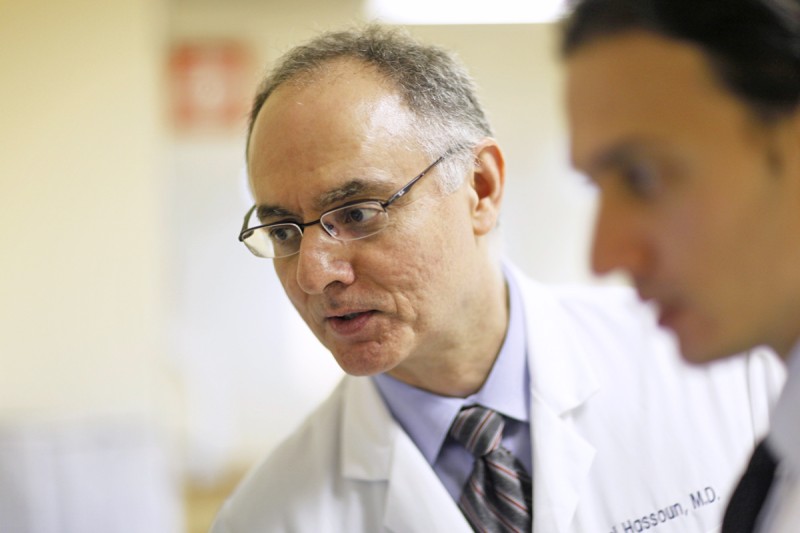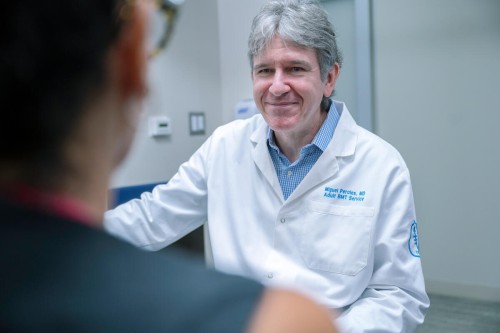
MSK hematologic oncologist Hani Hassoun is researching ways to improve stem cell transplants for people just diagnosed with multiple myeloma.
A stem cell transplant can be a good treatment for multiple myeloma. A successful transplant gives someone with multiple myeloma new, healthy bone marrow. It replaces the bone marrow harmed by myeloma cells.
Hematopoietic (hee-MA-toh-poy-EH-tik) stem cells (usually just called stem cells) grow into all types of blood cells. The white blood cells fight infection, red blood cells carry oxygen, and platelets help control bleeding.
You may hear your transplant called a stem cell transplant or a bone marrow transplant. A bone marrow transplant is a type of stem cell transplant.
With a bone marrow transplant, the stem cells are taken from the bone marrow.
With a stem cell transplant, the stem cells are taken from either the bone marrow or the bloodstream.
Types of transplants
There are 2 main types of stem cell transplants.
Autologous transplants are the most common type for multiple myeloma. Your stem cells are harvested (collected) from your body and frozen. Your own stem cells are put back in your body after you have chemotherapy.
Allogeneic transplants also can treat multiple myeloma. When you have an allogeneic stem cell transplant, stem cells are harvested (collected) from a donor.
The transplant process
For either type of transplant, you first get high-dose chemotherapy to kill cancer cells. Two days later, stem cells are infused (put back) into your bloodstream. This procedure is similar to a blood transfusion.
Over the next few days, the transplanted stem cells travel to your bone marrow. There, they grow into new mature blood cells.
It takes a few weeks for all the mature blood cells to grow and replace old blood cells. During this time, we will protect you from infections and bleeding. You may spend up to 3 weeks at the hospital after a stem cell transplant. Full recovery takes several months.
When they work well, autologous and allogeneic transplants give you a new, healthy bone marrow. Allogeneic transplants also give you a new immune system, built from your donor’s stem cells. Your new immune system may help protect you against cancer.
Gut microbiota and transplants
Protecting the gut microbiota in people who have transplants can prevent complications and protect their health. Your microbiota is the collection of all the microbes that live on and inside your body. They include viruses, bacteria, and other microorganisms.
MSK researchers are studying the connection between changes in the microbiota and successful transplants. We’re studying how the gut microbiome affects someone’s response to treatments with immunotherapy, including CAR T therapy.
Transplant results: Why choose MSK for a stem cell transplant?
MSK offers multiple myeloma treatments that have better results
The standard therapy for people with myeloma is high-dose chemotherapy together with a stem cell transplant. Research shows this treatment can help you live longer.
Some people have a very good response to high-dose chemotherapy. That means they do not need an autologous transplant right away.
MSK: Experts in stem cell transplants
MSK is one of the largest centers for stem cell and bone marrow transplants in the country. Most people who have their stem cell transplant at MSK have a very good recovery.
MSK’s success with transplants was highlighted in a 2012 study by the U.S. National Marrow Donor Program. People who had their allogeneic bone marrow transplant at MSK had a much higher predicted rate of 1-year survival.
First in transplants
MSK developed many of the transplant methods that are widely used today. This includes advanced new growth factors and other medications that boost the number of stem cells available for collection. This raises the chance of a successful transplant.
See a list of current clinical trials for multiple myeloma at MSK.






